- Numerical reasoning
- Verbal reasoning
- Logical reasoning
- Spatial reasoning
- Diagrammatic reasoning
- Mechanical reasoning
With aptitude tests, candidates can easily prove their ability to the recruiter, grabbing chances to stick out in a huge talent pool. Besides, candidates no longer worry about bias because the availability of different aptitude tests guarantees objectivity, accuracy, and speed throughout the hiring process.
So what is exactly included in aptitude tests? Are aptitude tests multiple-choice questions? Let’s find out now!
80% of aptitude tests are multiple-choice questions
Most of the aptitude tests (80%) on the market comprise a series of multiple-choice questions delivered under the following headings:
- Numerical Reasoning: Assesses a candidate’s ability to tackle and understand numerical data.
- Verbal Reasoning: Assesses a candidate’s ability to interpret concepts expressed through language.
- Logical Reasoning: Assesses a candidate’s ability to logically analyze problems through a set of rules that govern a scenario.
- Spatial Reasoning: Assesses a candidate’s ability to visualize and manipulate 2D and 3D objects.
- Diagrammatical Reasoning: Assesses a candidate’s ability to understand concepts via the use of diagrams and numbers.
- Mechanical Reasoning: Assesses a candidate’s ability to comprehend and apply mechanical and physical concepts.
Now take a deeper look at each type of test
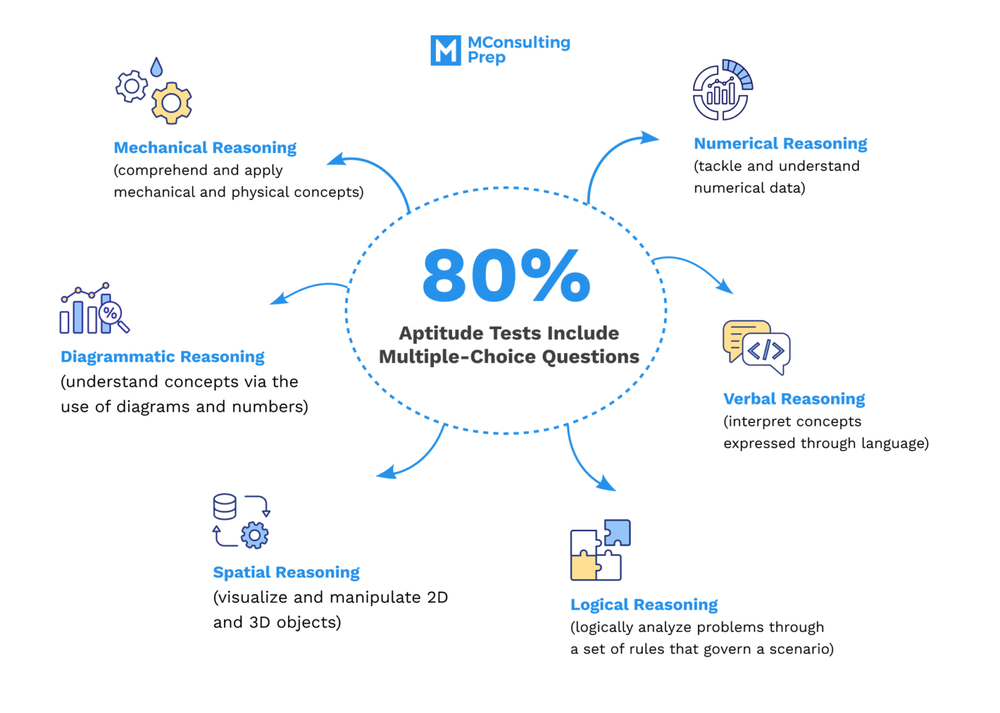
Numerical reasoning test
A numerical verbal reasoning test consists of 10-30 multiple-choice questions within a time limit of 15-45 minutes. Test takers are required to draw accurate conclusions from numerical or statistical data displayed in tables, charts, and graphs.
There are 4 common types of questions in a typical numerical reasoning test.
- Number sequence
- Calculation (no word problem)
- Word problem
- Data interpretation
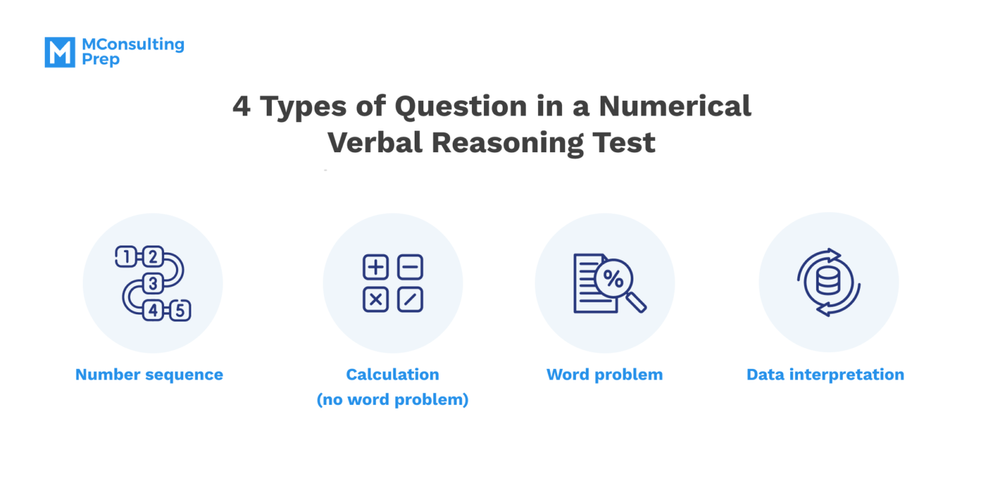
Number sequence
Number sequence (or number series) questions require you to find the missing number in a sequence by identifying its pattern.
These questions often contain 4-7 visible numbers along with 1, 2, or 3 missing numbers, depending on the sequence’s difficulty level.
For example: Find the missing number in the following sequence: 1, 3, 12, 52, 256, ?
Answer: Option A
Explanation: The above sequence includes two operations: multiplication and addition of a number by the same number.
The sequence goes like this: 1 x 2 +2 = 3, 3 x 3 + 3 = 12, 12 x 4 +4 = 52, 52 x 5 + 5 = 265
Following this logic, the next number will be 265 x 6 + 6 = 1596. The right answer is A.
Calculation questions assess your ability to add, subtract, divide, and multiply numbers quickly and correctly, as well as involve arithmetic terms and methods like ratios, percentages, and fractions.
Here are some examples of calculation questions:
Numerical word problems require you to solve calculation questions within a short context. This type is more challenging than calculation as test takers need to convert a word-based sentence into a mathematical equation.
Here’s an example of a word problem question:
For example: At a grocery store, apples cost 40 cents per ounce. Donna buys apples and ends up paying $10.00. How many ounces did she buy?
Answer: Option C
Explanation: $10.00 = 100 cents. The number of ounces Donna bought should be 1000/40 = 25. The right answer is C.
Data interpretation
Data interpretation questions require you to interpret and manipulate the types of numerical data frequently encountered in the workplace. Test takers are tested to:
- Make proper inferences and logical conclusions from numerical data
- Calculate values by using basic arithmetic operators
- Work with decimals, fractions, and percentages
- Interpret information displayed in tables, bar charts, line charts, pie charts, and caselet
Here’s an example of a data interpretation question:

Source: Cubiks
Answer: 40%
Explanation:
Investment in Italy is from the public sector: 0.5 billion
The total investment in Italy: 1.25 billion
The percentage of the investment in Italy from the public sector: 0.51.25 x 100% = 40%.
Verbal reasoning test
A verbal reasoning test typically includes 15-20 multiple-choice questions with a time limit of 15-20 minutes. These tests measure candidates’ ability to draw deductions from the given text.
There are 5 common types of questions in a typical verbal reasoning test, including:
- Synonyms & antonyms
- Analogy
- Word association
- Reading comprehension
- Verbal reasoning (make simple inferences)
Synonyms & antonyms
Synonyms & anonyms questions ask you to pick a synonym/ anonym out of a series of four or five words.
Look at these five nouns: amelioration, upgrade, deterioration, betterment, and enrichment. The four words (amelioration, upgrade, betterment, enrichment) have similar meanings (synonyms), and the rest one – deterioration – is a word with the opposite meaning (an antonym).
Analogy
Analogy questions measure your ability to recognize relationships between pairs or sets of words. These questions often have two words with a certain relation as an example pairing. Your task is to spot this relation and then match the third word to its corresponding one within multiple-choice answers.
Below’s an example of an analogy question:
bonsai is to tree as murmur is to …
In this case, “bonsai” is a type of “tree” – the relationship here is Item to category. Therefore, option A is the right answer because “murmur” belongs to “sound”.
Word association refers to a relation between one word and other words based on a semantic relationship. Word association questions ask candidates to choose the odd one out of the rest.
Word association questions are rarely seen in available verbal reasoning tests on the market. Only the test provider Cubiks includes these questions in its verbal reasoning tests.
Here’s an example of a word association question:
Answer: hammer
Explanation: “Screw”, “needle”, and “pin” are all pointed objects. So “hammer” is the odd one out.
Reading comprehension
Reading comprehension is in the form of multiple-choice questions, requiring you to read a passage quickly and answer questions based on the given information.
Below’s an example of a reading comprehension question:
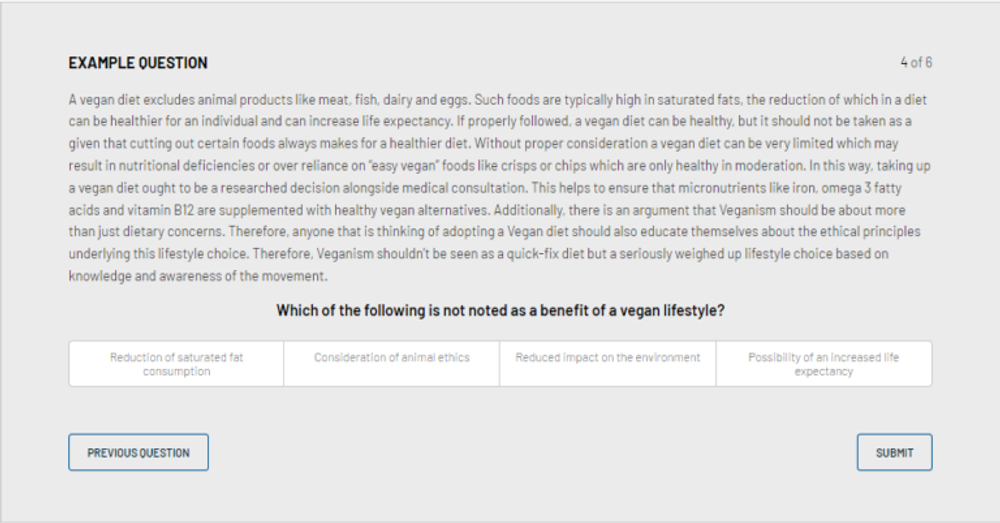
Source: Cubiks
Answer: Reduced impact on the environment
Explanation:
The keywords of the question are: “not” and “benefit of a vegan lifestyle”
The second sentence says, “Such foods are typically high in saturated fats, the reduction of which in a diet can be healthier for an individual and can increase life expectancy.”
=> Reduction of saturated fat consumption and Possibility of an increased life expectancy is mentioned as a benefit of a vegan lifestyle.
And at the end of the passage, “Therefore, anyone that is thinking of adopting a Vegan diet should also educate themselves about the ethical principles underlying this lifestyle choice.”
=> Consideration of animal ethics is also mentioned.
There are no details within the passage that mentions Reduced impact on the environment as a benefit of a vegan lifestyle.
Verbal reasoning (make simple inferences)
Verbal reasoning questions ask you to draw simple, logical inferences based on the information in the passage. They are multiple-choice questions, requiring you to choose from 3 options:
- True – The statement logically follows the information in the text.
- False – The statement CANNOT follow the information in the text.
- Cannot Say – It’s impossible to determine whether the statement is true or false according to the information in the text.
Here’s an example of a verbal reasoning question:

Source: Cubiks
The statement: Designers can join Puccia’s fashion school, which offers courses on the latest in fashion on their specialized online platform.
Answer: False
Explanation: The text says, “The Milan workshop also has a fashion school where aspiring designers can attend on-premises courses”, meaning these courses take place in the school’s buildings. This contradicts the information in the statement “courses on the latest in fashion on their specialized online platform”.
Logical reasoning test
A logical reasoning test covers 15-40 multiple-choice questions with a time limit of 25-45 minutes. In this non-verbal assessment, test takers need to analyze through logical and abstract reasoning, drawing rules and structures to reach the answers.
There are 3 main types of questions in a typical logical reasoning test, including:
- Deductive reasoning
- Inductive reasoning
- Abductive reasoning

Deductive reasoning
Deductive reasoning questions require you to logically and quickly make specific conclusions based on general ideas and premises. The majority of deductive reasoning questions are presented in the form of text, with 100% logical certainty.
Look at this simple example:
All tigers are animals.
All animals are warm-blooded.
By using deductive reasoning, you can conclude that all tigers are warm-blooded.
Here’s an example of a real logical reasoning test from SHL:
Review the facts below:
- Tim lives in a big apartment.
- Abby lives in a small apartment.
- There are no big apartments in Tinyville.
- Small apartments have one bedroom.
Which statement MUST be true?
1. Tim lives in Tinyville
2. Abby lives in Tinyville.
3. Big apartments have one bedroom.
4. Abby’s apartment has one bedroom.
5. Tim and Abby live in the same town.
Answer: D
Explanation: Abby lives in a small apartment + Small apartments have one bedroom
=> Abby’s apartment has one bedroom.
Inductive reasoning
Contrary to deductive reasoning, inductive reasoning involves logically making general conclusions by compiling evidence. Inductive reasoning questions require you to form a hypothesis by searching for an emergent pattern, with 80-90% of logical certainty.
On this type of question, you are presented with shapes in a certain sequence or matrix, then required to spot the patterns within a time limit.
Here’s an example of an inductive reasoning question:

Source: Cubiks
Answer: B
Explanation: In the given sequence, the two shapes on the right always reflect the two shapes on the left of the next block, and there is always one shaded shape rotating anti-clockwise.
Abductive reasoning
Abductive reasoning questions require you to logically make observations and find the hypothesis that would best fit or illustrate those observations.
Unlike deductive reasoning, these questions lead to a plausible conclusion without being positively verified. Abductive reasoning questions have a lower level of logical certainty than deductive and inductive ones.
This type of question is usually presented in case interviews instead of aptitude tests.
Spatial reasoning test
A spatial reasoning test involves 20-30 multiple-choice questions with a time limit of 15-30 minutes. The test measures candidates’ ability to think about 2D or 3D objects, visualize the movement of those objects or understand patterns between them.
Here’s an example of a spatial reasoning question:
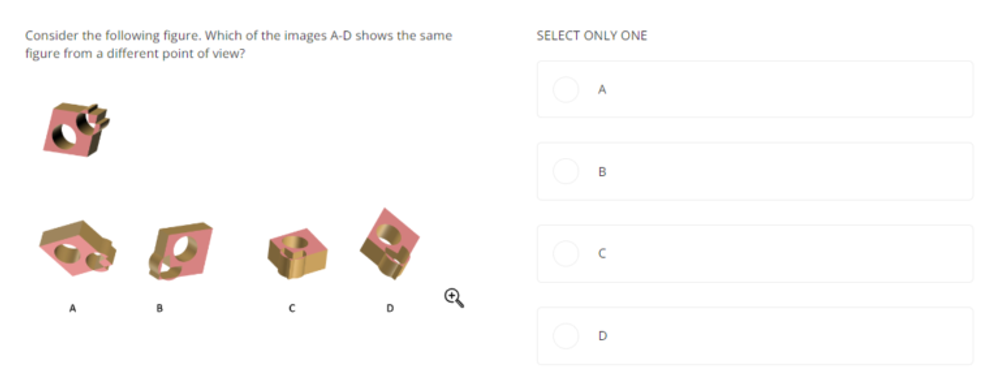
Source: TestGorilla
Diagrammatic reasoning test
A diagrammatic reasoning test consists of multiple-choice questions, requiring you to interpret information presented in a diagram. Specifically, candidates need to spot the rule or set of rules that govern a provided sequence and apply this logic to a new scenario to reach the right answer.
Here’s an example of a diagrammatic reasoning question:

Source: Saville
Answer: The last option
Explanation: The “T” operator changes the shading of each figure, so the INPUT will be the same in size and shape, but the shading is light.
Mechanical reasoning test
A mechanical reasoning test includes multiple-choice questions, which measure the ability to comprehend and apply mechanical concepts to solve problems. During the test, you can come across a few mechanical scenarios that can involve concepts like gravity, friction, acceleration, pressure, work and power, kinetic and potential energy, etc.
Below’s an example of a mechanical reasoning question:

Source: Saville
Answer: Direction B
Explanation: Since the handle is pulled to the right, the bar on the left is pulled in the same direction by the parallel link which keeps the bar and the handle together.
The other 20% is game-based
There are some test providers designing game-based questions in their aptitude tests, including Criteria and Pymetrics.
General aptitude mobile evaluation game by Criteria
This is a mobile-first, gamified assessment of cognitive aptitude by Criteria. It consists of 3 short mini-games that take about 5-6 minutes to finish. Users can play the games on any device, including mobile phones, tablets, and desktop computers.
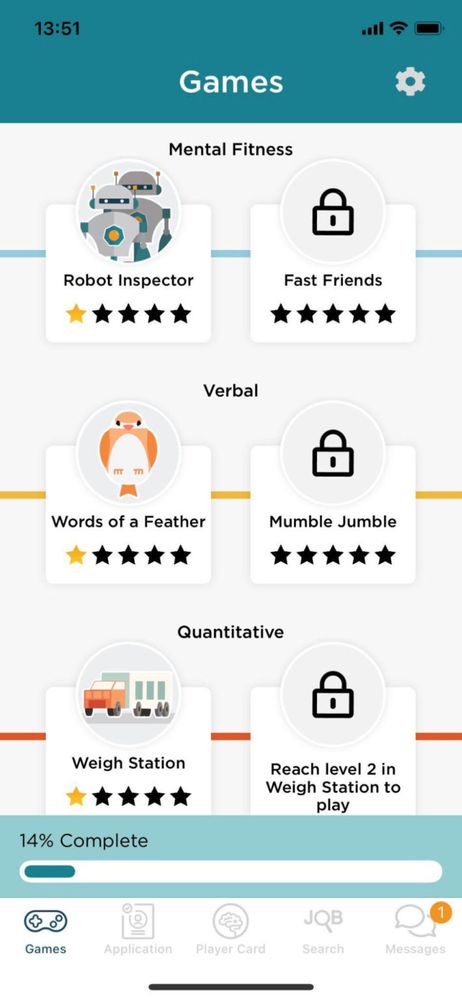
Source: JobFlare/ Criteria Corp
There are two levels in each mini-games:
- Mental Fitness
- Level 1: Robot Inspector
- Level 2: Fast Friends - Verbal
- Level 1: Words of a Feather
- Level 2: Mumble Jumble - Quantitative
- Level 1: Weigh Station
- Level 2: Infruition
Numerical and logical reasoning games by Pymetrics
Pymetrics have designed 4 games related to numerical and logical reasoning, which may take about 7-10 minutes to complete.
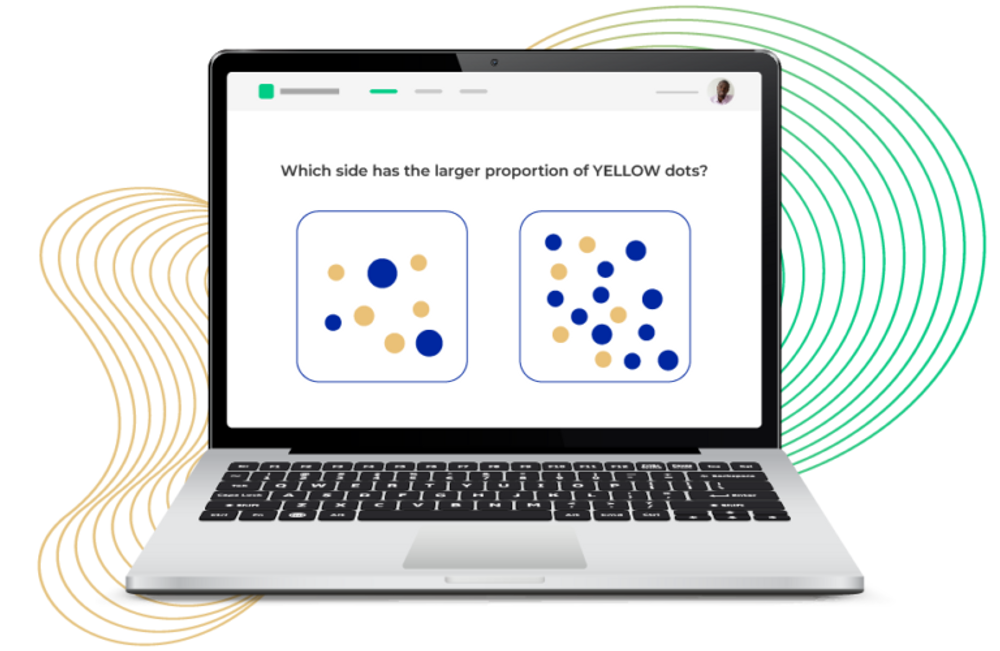
Source: JobFlare/ Criteria Corp
/filters:quality(75)//case_thumb/public/1699589977462_aptitude_tests_package_4_x.png)